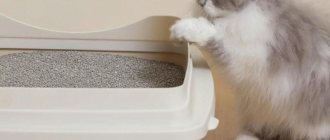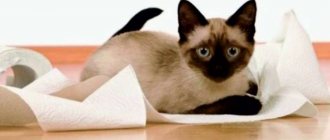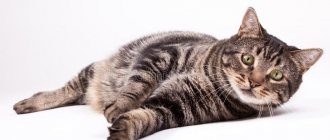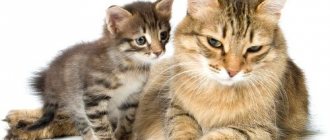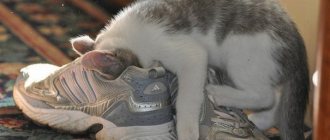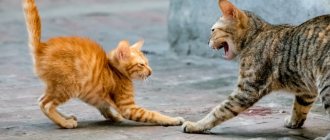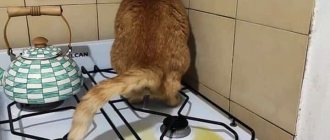I have a Highland Fold cat, he stopped going to the litter box, no matter what I did, I bought sprays and washed them with different products, but he still walks past the litter box. Tell me what to do? Olga
Agree, the problem is painful. And so much so that sometimes it becomes the reason for abandoning the animal.
So, one day the pet suddenly stops going to its native litter box. It seems like out of the blue (from the owner’s point of view). Maybe completely, or maybe partially, which is not clear at all.
Two traditional questions arise: Who is to blame? and What to do? Well, let's try to figure it out.
A cat may begin to ignore its litter box for two reasons – medical and behavioral.
Health problems
The pussy has its own opinion about why a litter box is needed.
Cats often stop using the litter box due to various diseases. Sometimes they are simply unable to control the process. For example, with diarrhea. Other possible causes are diabetes, inflammation of the urinary tract and intestines, kidney disease, etc. With arthritis, a cat cannot climb into a tray with high sides. So she does the best she can - she goes to the toilet next to him.
Older cats over 10 years old have memory problems. They forget where the litter box is and are forced to use other places as a toilet.
It is important to understand that any changes in your pet's behavior may be a sign of illness. If your cat stops going to the litter box, it makes sense to take her to the vet first.
Why does a cat refuse to walk small?
There are several diseases in which a cat does not pee at all. All of them are associated with pathologies of the excretory system and reproductive system.
- Anuria
A pathology in which the kidneys stop producing urine. Experts talk about partial or complete renal failure. During the course of the disease, severe intoxication of the body develops. There are acute and chronic courses of the disease. In the first case, the following symptoms are present:
- weakness;
- apathy;
- diarrhea;
- vomit;
- increased heart rate;
- refusal to eat;
- decreased body temperature;
- weak urination or its complete absence;
- dehydration.
In the chronic form of the disease, there are no obvious symptoms for a long time. In this case, you may initially notice frequent trips to the toilet, thirst, and then a lack of urination, emaciation, a strong smell of urine from the mouth, mouth ulcers, vomiting, and faded fur. Advanced forms cannot be treated and the disease is fatal.
- Cystitis
It is an inflammation of the lining of the bladder. Provoking factors are bacteria, infection, obesity, exhaustion, mechanical damage, metabolic disorders. There are acute and chronic cystitis. In the first case, the symptoms are pronounced. The disease can be detected by the following symptoms:
- frequent trips to the litter box without urine excretion;
- thirst;
- bloated belly;
- irritability;
- increased body temperature;
- involuntary discharge of urine with a strong, unpleasant odor;
- irritability.
A dangerous sign is the absence of urine in the tray for two days. With such symptoms, the animal may die. Chronic cystitis occurs without obvious manifestations; most often it can be noticed by impaired urination. The most susceptible to the disease are sterilized pets and cats with diabetes and obesity.
Lack of cleanliness
Cats are quite squeamish and also sensitive to odors. If the toilet smells bad, they won't use it. The most fastidious people do not go to the litter box in a big way if they have already gone to it once. They are only satisfied with an absolutely clean place. In this case, having several trays in the apartment and frequent cleaning will help.
You need to clean your cat's litter box every day, preferably twice. In addition, it should be washed with an unscented cleaner or baking soda once a week.
If the tray is already old, then the cat may consider it unsuitable for use, no matter how thoroughly the owner washes it. Buying a new toilet will solve this problem.
Remove tag odor
How to train a toy terrier to “walk” on a diaper
Many pet owners face a serious problem - the appearance of odor from cat marks. The cause of the unpleasant odor lies in the composition of the urine:
- urochrome stains urine;
- urea makes urine sticky (when the mark area dries);
- uric acid crystallizes in cat urine and these crystals do not dissolve in water, so it is difficult to remove.
If you wash the mark area with plain water, the smell will still remain. Even if you don’t feel it, it will appear again in just a couple of days, as it has become deeply ingrained into the surface.
It is difficult to remove odor from a surface that absorbs moisture well.
Today, there are many methods for getting rid of the smell left by cats.
Folk remedies
When an adult cat or a small kitten begins to shit, it is necessary to correct the situation. With the help of folk remedies, you can quite successfully get rid of cat marks. It is not difficult to remove marks from hard surfaces. Even plain water mixed with a special product can do the job just fine. But if the cat left marks on upholstered furniture, you will have to work hard.
When removing cat tags, you must wear rubber gloves. You need to start cleaning the area right away. If you start cleaning in time, the uric acid will not have time to crystallize. When time is lost, it is almost impossible to clean without chemicals.
How to cleanse using folk remedies:
- vodka or alcohol effectively destroys organic molecules that cause odor. Alcohol is able to penetrate deeply into the tissue;
- Vinegar is an excellent mark remover. It is diluted with water in a ratio of 3:1 and the required area is wiped with a moistened sponge. The smell of vinegar dissipates over time;
- baking soda. It is mixed with vinegar. First, the mark area is generously sprinkled with soda, and then vinegar is poured. A chemical reaction occurs and the smelly, organic components disappear. This method must be used carefully, and it is not suitable for all surfaces.
Cleaning tags with folk remedies
Great for fighting cat marks:
- hydrogen peroxide;
- iodine diluted with water;
- strong brew;
- potassium permanganate.
Important! Ammonia cannot be used. The ammonia contained in ammonia can attract your pet.
Store formulations
When folk remedies do not help, special preparations are needed that can remove the odor. Pet stores offer many products that can be used to remove cat marks.
The acid contained in the urine of pets is easily evaporated under the influence of special agents.
Pet stores and hardware stores offer many products that can eliminate unpleasant odors in the home. Drugs such as Fukrtsin, Odorgon, Bio-Zh, Dufta Smoke and others neutralize uric acid contained in cat urine. The action of special preparations is aimed not only at eliminating unpleasant odors, but also at destroying harmful microbes. They are not difficult to apply. The marked area is treated with the drug and left for 30 minutes or more. Then remove the product with a damp cloth and wipe the surface dry.
Cleaning tags with special means
Not only liquid preparations, but also various sprays (Formidron, Anti-odor) can quickly cope with the task. The area where the cat has been is sprayed with a spray bottle, then, if necessary, wiped with a dry cloth. These products can be used to remove odors from tagged shoes.
To prevent unpleasant consequences associated with odor in an apartment or house, it is necessary to monitor the animal. You need to use all measures to wean your cat from walking past the litter box. Time will pass, and the pet will stop ignoring the tray.
Bad place
Sometimes cats are not satisfied with the space allocated for the toilet. It should be quiet and calm, where no one will disturb them. There is no need to place the tray next to the door or washing machine. Also, do not place it near food bowls or where the cat likes to rest.
If the cat is not satisfied with the place, you can move the tray to the place where she began to shit. It is better to wash soiled areas with preparations that do not contain ammonia, since urine also contains this component. For a cat, such a smell means that this place is intended for the toilet.
The situation can be corrected if the tray is always available. If it is in a toilet that is occupied by the owner, you can expect an unpleasant pile or puddle to appear in the wrong place.
Behavioral aspect
Well, what could be easier than to explain the behavior of a cat? Unless you prove Fermat's theorem
The main psychological reasons for the uncleanliness of cats:
- Disgust: I don’t like the place where the tray is. Or its filler
- Preference: I like a certain place (oh, but the tray is not there at all!). Or a certain filler (and which one, let the owner guess for himself)
- Insufficient cleanliness of the toilet: the filler must be changed in a timely manner, and the tray must be washed. And preferably with a soap solution, and not a toxic chemical
- Intraspecific aggression: social friction between cats living in the same apartment
- Increased anxiety: stress caused by moving or renovation, the appearance of a new family member or animal, changes in noise or smell, family quarrels, a trip to the clinic, resentment towards the owner, etc. For example, the reason for walking past the potty may be the appearance of a small child in the neighbors' house. Go figure!
If a cat leaves “standard” puddles or piles in the wrong place, then this is most likely a psychological problem. If urination is frequent and in small portions, a doctor is needed. The same thing applies to “unhealthy” stools.
From personal experience. When puddles or piles are left in the “frontal area” (on the sofa, bed or just in the middle of the room) – this is generally revenge. Think about what you did wrong?
A medical cause can easily turn into a behavioral one and vice versa. Painful sensations when urinating or defecating during illness are transferred by the cat to its tray and create a persistent aversion to it, which remains even after recovery. And severe stress, in turn, can provoke some kind of disease of the genitourinary system (idiopathic cystitis, urolithiasis).
It happens that both medical and behavioral causes are present at the same time. Bingo!
Unsuitable filler
High-quality litter is the key to success
Sometimes cats don’t like the smell of litter. Various fragrances that are pleasant to humans sometimes cause disgust in pets. The type of filler is also important. The cat may not like it if it has been changed. In addition, some animals prefer one type of litter for defecation and another for urination. You can let your cat choose what she likes best. To do this, you need to place several containers with different fillers nearby and observe which ones she uses.
Too deep a layer of filler can also cause rejection in the cat. Usually it is enough to pour 2.5-5 cm.
What to do?
Sometimes diseases whose symptom is constipation can be accompanied by other diseases. Treatment of a disease whose symptom is constipation can only be prescribed by a doctor.
Carrying out examinations on your own at home is problematic and not always effective. But you shouldn’t panic because your pet is unwell either. What should the owner do first:
- Analyze the cat’s nutrition and behavior over the last 2-3 days. Constipation may have been caused by overeating or eating unwanted foods.
- Feel the stomach. Do not press too hard. Pay attention to the animal’s reaction: does palpation cause pain.
- Give more water, stop feeding.
- If constipation occurs after surgery, go to the hospital without delay.
After analysis and determination of the severity of the symptom, it is prohibited to give any medications. Only a veterinarian can make a final diagnosis, as well as prescribe additional examinations (x-rays, ultrasound examinations, urine tests).
Helping adult cats
Adults may be prescribed enemas with the addition of oil and take laxatives. Directions, purposes, and the name of the drug are prescribed by the veterinarian. Unauthorized use is dangerous for the health and life of the cat and can provoke a worsening of the condition.
Help kittens
If a problem stool is detected in a kitten, its diet, quality of drink and food are analyzed.
If a problem stool is detected in a kitten, its diet is analyzed
The maximum assistance that the owner can provide during a pre-medical examination:
- light massage of the kitten's belly;
- starvation diet;
- drinking plenty of fluids.
If the kitten’s condition worsens or stool does not normalize, urgently seek help from a veterinary clinic.
Important! Do not attempt to treat an animal without the appropriate instructions from a doctor with dosage forms intended for an adult or child.
Enema appointment
Significant results are achieved by using an enema. The method is simple, but it is better not to use it without some practice. The first time is done by a veterinarian.
How to give an enema to a cat with constipation
For the procedure you will need a syringe without a needle and Vaseline oil, chamomile, water. Chamomile decoction can be replaced with saline solution.
Be sure to read:
How to remove the smell of cat urine: products for removing acrid odors from pets
How to perform an enema:
- Prepare chamomile decoction or saline solution at the rate of 1 tsp. chamomile or salt per 1 glass of water.
- Give cats a small amount of Vaseline oil 1-1.5 hours before the enema.
- Lubricate the tip of the syringe (the place where the needle is connected) with Vaseline and sunflower oil. Gently insert into the anus. If you have a syringe, the insertion depth should not exceed 1.5-2 cm.
- Pinch the anus with your tail. Keep the animal in your arms in this state for a quarter of an hour.
What to do at home if your cat is constipated?
Significant results are achieved by using an enema.
Douching as a method gives a positive result. But cats don’t like it, as they experience pain during the enema. Also, frequent use of a syringe as an aid has the opposite effect: the intestines stop functioning normally, and in 75% of cases the procedure provokes the appearance of ulcers.
It is strictly forbidden to use douching if:
- pregnant cat;
- the animal suffers from cardiovascular diseases;
- blood clots and bleeding were noticed;
- there are violations of the integrity of the skin in the genital area.
Important! It is dangerous to resort to self-treatment if frequent constipation occurs.
Unpleasant associations
Despite all their independence and proud disposition, cats are sensitive creatures. If something unpleasant happens to them while using the litter box, they will begin to avoid it. For example, after they were scared.
Bad associations also arise when, due to some disease, it was painful for the cat to go to the toilet. Even after recovery, she may have unpleasant memories and begin to ignore the litter box. Changing the tray, its location, as well as artificially creating pleasant associations will help here. Just don’t give your pet something tasty while he’s using the toilet. Cats are uncomfortable with excessive attention during this intimate process. Also, do not keep them in the tray against their will.
Sometimes owners themselves unknowingly form a negative attitude towards the toilet in cats. When a pet goes the “wrong” way, the owners are indignant and lock him in the bathroom along with the litter box so that he finally understands which place is intended for toilet matters. They will also spank you a couple of times for added credibility. All that will remain for the cat from such “upbringing” is the persistent belief that the litter box means screaming and punishment. The pet will have no desire to spend time in it.
Reason #10: demonstrative behavior
Perhaps walking outside the litter box is a sign the cat is sending you. Sometimes this happens when he wants to draw attention to a problem, for example, with health or improper placement of the tray. Sometimes provocative behavior is dictated by the fact that the pet wants to receive additional attention from you.
At first he didn’t receive enough attention, but then he noticed that you scolded him for his misdeeds, that is, you paid attention to him. After that, the cat began to do this just to get another portion of attention from you. You say it's stupid because it's negative attention? No, it's not stupid. This is how not only cat psychology works, but also human psychology: negative attention is much better than complete indifference. Watch the following video about people and you will understand a lot about cats.
Article continues after advertisement
Stressful situation
It is not uncommon for a cat to stop using the litter box when she is stressed. Causes of concern may include the arrival of a newborn baby or another family member in the home, the acquisition of a new pet, or a conflict with other animals. Even rearranging or changing your normal daily routine can cause anxiety.
It is not recommended to poke the cat's nose into the puddle. This not only creates stress for him. He may decide that going to the toilet is a punishable offense, and begin to look for the most secluded corners to do this, so that traces of the crime are more difficult to detect.
The cat may feel abandoned and unwanted. This is a common cause of litter box problems. It makes sense to find some time during the day to pet her, play with her, or treat her to something tasty.
Expression of dissatisfaction
Sometimes cats show their dissatisfaction by refusing to go to the litter box and choosing completely inappropriate places for the toilet, for example, going anywhere on the floor. This is how they express their resentment if they believe that they have been treated unfairly. The reasons may be less serious. For example, they had to wait too long for dinner, they don’t like the new food, their favorite bed was moved to another place.
It is not necessary to persist in the little things and show the cat who is boss in the house. If possible, it is better to meet her halfway and return the bed or the previous brand of food.
Reason #13: old age
In old age, not only people can suffer from incontinence, but also cats. Plus their mental abilities deteriorate. Then the cats start peeing and pooping anywhere. Don’t scold the respectable animal: it’s already difficult for him and he doesn’t do it on purpose. Instead, buy a litter box with low sides if you find that your pet has difficulty getting into the toilet. And it’s better to place several trays around the apartment so that the cat has time to reach them. Well, if your cat has incontinence, buy special cat diapers.
